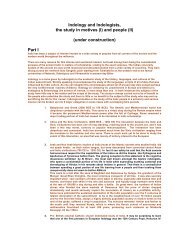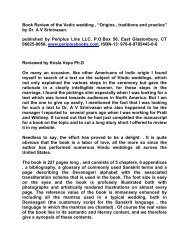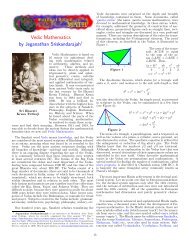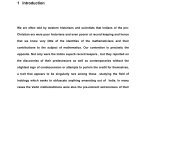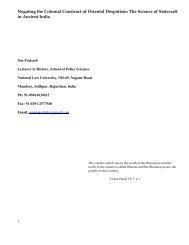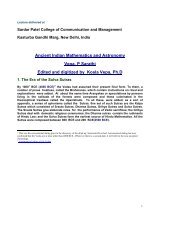The Dhaarmik Traditions - Indic Studies Foundation
The Dhaarmik Traditions - Indic Studies Foundation
The Dhaarmik Traditions - Indic Studies Foundation
Create successful ePaper yourself
Turn your PDF publications into a flip-book with our unique Google optimized e-Paper software.
sunchronization with the solar cycle. It turns out that it takes nineteen years to bring the<br />
two cycles in synchronization , so that a new moon occurs exactly on the same solar day<br />
that it did 19 years ago.<br />
83 Mitanni when the Hittite and the Mitanni ( 2 neighboring kingdoms in Anatolia, present day<br />
Turkey signed a treaty they invoked the blessings of their Gods . <strong>The</strong> invocation is<br />
addressed to the Nasatyas, Mitra and Varuna,Hindu Vedic deities from a distant past<br />
84 Moksha "Liberation." Freedom from rebirth through the ultimate attainment, realization of the Self<br />
God, PArasiva. <strong>The</strong> spiritual attainments and superconscious joys, attending<br />
renunciation and yoga leading to Self Realization. Moksha comes through the fulfillment<br />
of dharma, artha and kAma (known in Tamil as aram, porul and inbam, and explained by<br />
Tiruvalluvar in Tirukural) in the current or past lives, so that one is no longer attached to<br />
worldly joys or sorrows. It is the supreme goal of life, called paramartha. This is a<br />
distinction between the DhArmic traditions originating in the Indian subcontinent from<br />
the very earliest time periods in history and other religious belief systems. <strong>The</strong><br />
propensity to cater to the higher needs (in the Maslow hierarchy) from the very inception<br />
of the tradition is a uniquely <strong>Indic</strong> development. Merely to emphasize this as a spiritual<br />
characteristic is to mnimize the<br />
85 mumukshutwa Pragmatic and psychological needs of the human species which is a distinctive<br />
characteristic of <strong>Indic</strong> dharma. An intense thirst for Brahmavidya or higher knowledge<br />
(Paara Vidya)<br />
86<br />
87 Nakshatras <strong>The</strong> concept of positing 27 Nakshatras in the sidereal zodiac goes back to antiquity at<br />
least in India. the ancients divided the sky in 27 or 28 lunar mansions or Nakshatras,<br />
characterized by asterisms (apparent groups of stars), one for each day that the Moon<br />
follows its track among the stars.<br />
88<br />
89 nididhyasanam the final step of the 3 step process of sravanam, mananam, nididhyasanam, involves<br />
deep meditation and requires mumukshutwa and titiksha<br />
90 Nirukta this treatise was authored by Yaska and deals with Etymology , a branch of Linguistics,<br />
the study of the roots of all words, made simpler by the intentional highlighting of<br />
Dhaatu in sanskrit. Yaska is one of the bright galaxy and plethora of broad spectrum<br />
philosophers among the ancient Vedics, who counted numerous skills in their repertoire<br />
linguistics being just one of their many fields of expertise<br />
91 Nighantu Yaska's Vedic Glossary,Nirukta is a commentary on the Nighantu<br />
92 Nirvana blown out or extinguished as in the case of a lamp. Nirvana is generally used to refer to a<br />
material life that has been extinguished, i..e. for one who has achieved freedom from<br />
rebirth. <strong>The</strong> term Nirvana is commonly used in Buddhism as the final stage a practitioner



